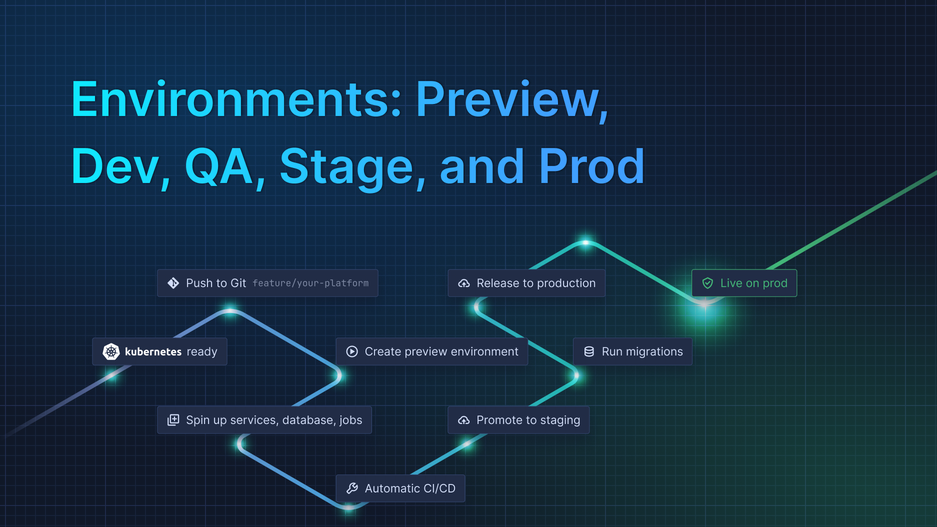

Dev, QA, preview, test, staging, and production environments. What's the deal?
Imagine you’re a developer. You’ve just nailed down a new feature, and you’re pumped to see it in action. But wait—where does it go first? Do you test it on your local setup? Push it straight to production (yikes)? Or maybe you’ve heard whispers of QA, staging, and other mystical environments.

If you’ve ever wondered what all these development environments are for and how they fit together, we’ve got you. 🙂
Development environments—like QA, dev, test, staging, preview, and production—are essential stages in the software development lifecycle (SDLC). They ensure your software works perfectly at every phase, from initial builds to final deployment.
In this guide, we’ll break it all down and show how Northflank can take the stress out of managing these environments. Further reading can be found in the Northflank documentation: Release for production, getting production ready, create a pipeline and release flow, and creating a preview environment.
The dev environment is where the magic begins. It’s your sandbox in the software development lifecycle, where developers write, debug, and refine their code. This software environment allows teams to experiment safely without impacting live systems.
- Fast feedback loop: Allows for quick code changes and testing.
- Minimal dependencies: Typically uses mocked data or stubbed APIs for simplicity.
- Experimental: A safe space to try new things without impacting anyone else.
- Writing new features.
- Debugging code.
- Experimenting with creative solutions.
- Limited visibility: It’s hard to know how changes will work with the full system.
- Consistency issues: If local setups differ among team members, bugs might slip through.
Northflank provides lightweight containerized dev environments, so every developer has an identical setup, eliminating the classic “it works on my machine” issue.
A preview environment is a temporary, fully functional replica of your application—often created automatically for every pull request or feature branch. It’s designed to streamline collaboration and code review, enabling teams to see changes in action before they are merged into main or staging.
- Ephemeral: Automatically spun up and torn down based on pull requests or short-term testing needs.
- Close to production: Mimics the production setup as closely as possible—down to configuration and environment variables.
- Shareable: Generates a unique URL so team members (and even stakeholders) can easily review and test the new feature in real time.
- UI/UX validation: Quickly share new UI or layout changes without impacting the dev or staging environment.
- Team & stakeholder feedback: Gather direct feedback from QA, product managers, or designers on in-progress changes.
- Quick regression checks: Confirm that new code doesn’t accidentally break existing features in an environment that behaves like production.
- Ephemeral environment sprawl: Managing multiple short-lived environments can become complex if not automated properly.
- Resource constraints: Large or resource-intensive apps might strain infrastructure if many preview environments run concurrently.
- Environment drift: Ensuring each preview environment accurately reflects the latest configuration and dependencies can be challenging.
Northflank’s integrated preview environments automatically create isolated, full-stack deployments for each new branch or pull request. This eliminates manual environment configuration and speeds up reviews:
- Automated provisioning: Hooks into your Git provider to spin up environments based on PR activity.
- One-click tear-down: Safely remove preview environments once the feature is merged or closed.
- Consistent configurations: Uses the same container images and environment variables to prevent “configuration drift.”

The QA environment is your testing battleground, where code is validated to ensure it meets functional, security, and usability standards. This plays a critical role in the testing workflow of your development lifecycle. Unlike the dev environment, QA focuses on structured testing in a controlled environment.
- Structured testing: Automated and manual test suites ensure features behave as expected.
- Stable data: Often uses snapshots or controlled test data to replicate real-world conditions.
- Isolated: Dedicated to testing, preventing interference from other environments.
- Verifying bug fixes.
- Running automated regression tests.
- Ensuring new features don’t break existing functionality.
- Synchronization: Keeping QA aligned with staging and production environments can be tricky.
- Bottlenecks: Automated tests can slow down when dealing with complex or large systems.
Manual testing is the process where testers manually execute test cases without using automation tools to validate the application’s functionality. It’s especially crucial for ensuring usability, exploratory testing, and verifying features that require human judgment.
The approval stage follows manual testing and involves key stakeholders—including PMs, QA engineers, and developers—collaborating to review the results and approve the release for the next phase. This stage ensures every detail is scrutinized before the code progresses further.
When planning project budgets, understanding ranges of software developer salary can help allocate resources effectively during the approval stage.
Northflank’s environment management simplifies this process by creating consistent, isolated setups that streamline collaboration. Teams can efficiently identify issues, ensure all checks are completed, and confidently sign off on releases.
The test environment focuses on specific validation tasks, often serving as a complement to QA. It’s especially critical for integration testing, where different components are tested together to ensure they work seamlessly.
- Integration focused: Tests APIs, databases, and external services working together.
- Data accuracy: Uses controlled data to mimic production scenarios.
- Repeatable: Designed for consistent testing conditions.
- Validating API requests and responses.
- Testing database migrations.
- Ensuring compatibility with third-party integrations.
- Setup time: Creating realistic test environments can be time-consuming.
- Data integrity: Ensuring data doesn’t accidentally leak into production.
Northflank’s pre-configured test environments with real-world data replicas allow faster integration tests without the hassle of manual setup. Learn how to set up release workflows with Northflank, or how to setup migrations or job runs.

The staging environment is a near-perfect replica of production, providing the last line of defense before deployment. Here, everything from performance to user experience is tested.
- Production parity: Mirrors production in terms of data, configuration, and load.
- End-to-end (E2E) testing: Validates real-world workflows and scenarios.
- User Acceptance Testing (UAT): Stakeholders sign off before deployment.
- Load testing to ensure performance under peak conditions.
- Testing deployment pipelines.
- Running final checks on user experience and design.
- Resource heavy: Staging environments can be costly to maintain.
- Drift: Even small differences from production can introduce issues.
With Northflank, creating staging environments that mirror production is seamless. You can quickly replicate configurations, run end-to-end tests, and tear down the environment when done.
We recommend leveraging a combination of robust, large-scale staging environments that closely replicate production and lightweight, ephemeral dev environments. Large staging environments serve as high-fidelity replicas for end-to-end testing, performance checks, and stakeholder sign-offs. Meanwhile, ephemeral dev environments, created dynamically for specific branches or pull requests, enable engineers to quickly deploy and validate feature benches in isolation.
This eliminates the need to wait for shared staging environments, minimizes contention for resources, and ensures faster feedback loops. By doing this, teams can accelerate the merge, test, and deployment process while avoiding infrastructure bottlenecks, ultimately reducing time-to-release.
The production environment is where your application lives for real users. Stability, performance, and reliability are non-negotiable. Any downtime or bugs here directly impact users.
- Live data: Interacts with actual user data.
- Monitored: Tracks performance, errors, and user behavior in real-time.
- Highly secure: Implements strict access controls and backup systems.
- Running the live application.
- Monitoring user activity and feedback.
- Responding to issues in real time.
- Debugging risks: Diagnosing issues without disrupting users is tough.
- Change management: Every update carries potential risks.
Northflank simplifies production deployments with features like rolling updates, automatic rollbacks, and real-time monitoring. This ensures smooth operation and a great user experience. Get your production environment ready with this checklist.
A whirlwind tour through dev environments, preview environments, QA environments, test environments, staging environments, and production environments. ALL OF THE ENVIRONMENTS.
Over 35,000 developers already trust Northflank to handle their environments.
Wrestling with mismatched configurations, buggy setups, or endless DIY solutions is the coding equivalent of trying to cut down a tree with a butter knife. Sure, you could do it, but why would you when there's a chainsaw sitting right there?
Book a demo here or try it for yourself here.
| Environment | Purpose | Key features | Use cases | Challenges | How Northflank helps |
|---|---|---|---|---|---|
| Dev environment | A sandbox for developers to write, debug, and refine their code. | - Fast feedback loop - Minimal dependencies - Experimental | - Writing new features - Debugging code - Experimenting with solutions | - Limited visibility - Consistency issues across setups | Provides lightweight, containerized setups to ensure consistency and eliminate "it works on my machine" issues. |
| QA environment | Validates code functionality, security, and usability through structured testing. | - Structured testing (manual & automated) - Stable data - Isolated | - Verifying bug fixes - Regression tests - Ensuring feature compatibility | - Synchronization with staging/production - Automated test bottlenecks | Enables realistic, production-replicated QA environments with automated provisioning and tear-down. |
| Test environment | Focused on integration and validation of components and services working together. | - Integration testing - Controlled data - Repeatable conditions | - API validation - Testing database migrations - Third-party integrations | - Time-consuming setups - Data leakage risks | Offers pre-configured environments with real-world data replicas for faster integration testing. |
| Preview environment | Temporary, isolated replicas for each PR or feature branch. | - Ephemeral -Close to production - Shareable unique URLs - Controlled data - Repeatable conditions | - UI/UX validation - Team & stakeholder feedback - Quick regressions | - Environment sprawl - Resource constraints - Environment drift | Automates provisioning for each pull request, offering consistent configs and easy tear-down. |
| Staging environment | A near-perfect replica of production for end-to-end testing before deployment. | - Production parity - End-to-end testing - User Acceptance Testing (UAT) | - Load testing - Testing pipelines - User experience validation | - High resource costs - Potential drift from production | Supports seamless creation of production-mirroring staging environments with ephemeral alternatives. |
| Production environment | The live environment where the application runs for end-users. | - Live data - Real-time monitoring - High security | - Running live applications - Monitoring performance - Debugging issues | - Difficult debugging without disruption - Managing risks of updates | Simplifies deployments with rolling updates, rollbacks, and real-time monitoring. |
